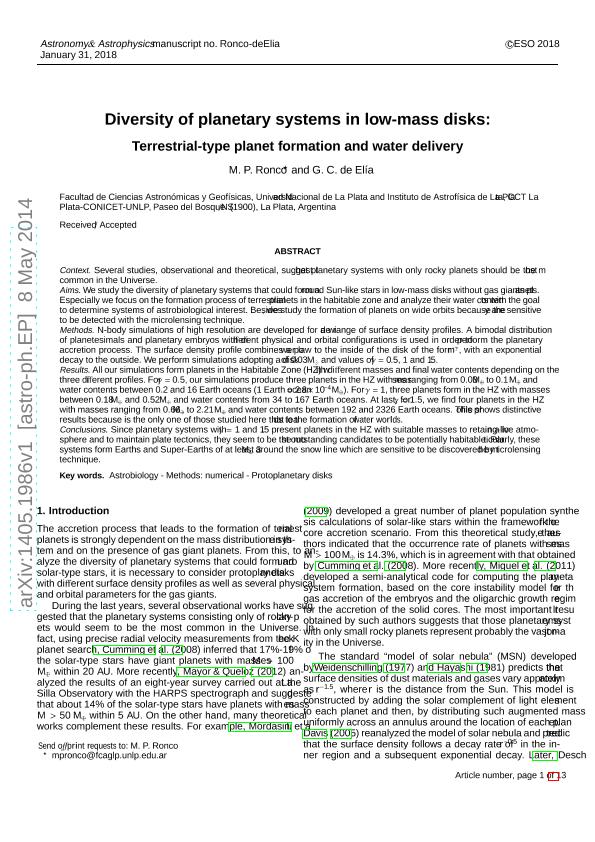Artículo
Diversity of planetary systems in low-mass disks: Terrestrial-type planet formation and water delivery
Fecha de publicación:
07/2014
Editorial:
EDP Sciences
Revista:
Astronomy and Astrophysics
ISSN:
0004-6361
Idioma:
Inglés
Tipo de recurso:
Artículo publicado
Clasificación temática:
Resumen
Context. Several studies, observational and theoretical, suggest that planetary systems with only rocky planets are the most common in the Universe.<br />Aims. We study the diversity of planetary systems that might form around Sun-like stars in low-mass disks without gas-giant planets. We focus especially on the formation process of terrestrial planets in the habitable zone and analyze their water contents with the goal to determine systems of astrobiological interest. In adittion, we study the formation of planets on wide orbits because they can be detected with the microlensing technique.<br />Methods. N-body simulations of high resolution were developed for a wide range of surface density profiles. A bimodal distribution of planetesimals and planetary embryos with different physical and orbital configurations was used to simulate the planetary accretion process. The surface density profile combines a power law for the inside of the disk of the form r−gamma , with an exponential decay to the outside. We performed simulations adopting a disk of 0.03Msun and values of gamma = 0.5, 1 and 1.5.<br />Results. All our simulations form planets in the habitable zone (HZ) with different masses and final water contents depending on the three different profiles. For gamma = 0.5, our simulations produce three planets in the HZ with masses ranging from 0.03 Mearth to 0.1 Mearth and water contents between 0.2 and 16 Earth oceans (1 Earth ocean = 2.8× 10−4 Mearth). For gamma = 1, three planets form in the HZ with masses between 0.18 Mearth and 0.52 Mearth and water contents from 34 to 167 Earth oceans. Finally, for gamma = 1.5, we find four planets in the HZ with masses ranging from 0.66 Mearth to 2.21 Mearth and water contents between 192 and 2326 Earth oceans. This profile shows distinctive results because it is the only one of those studied here that leads to the formation of water worlds.<br />Conclusions. Since planetary systems with gamma = 1 and 1.5 present planets in the HZ with suitable masses to retain a long-lived atmosphere and to maintain plate tectonics, they seem to be the most promising candidates to be potentially habitable. Particularly, these systems form Earths and Super-Earths of at least 3Mearth around the snow line, which can be discovered by the microlensing technique.
Palabras clave:
Astrobiology
,
Numerical Methosd
,
Protoplanetary Disks
Archivos asociados
Licencia
Identificadores
Colecciones
Articulos(IALP)
Articulos de INST.DE ASTROFISICA LA PLATA
Articulos de INST.DE ASTROFISICA LA PLATA
Citación
Ronco, María Paula; de Elia, Gonzalo Carlos; Diversity of planetary systems in low-mass disks: Terrestrial-type planet formation and water delivery; EDP Sciences; Astronomy and Astrophysics; 567; A54; 7-2014; 1-13
Compartir
Altmétricas




